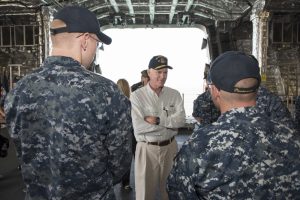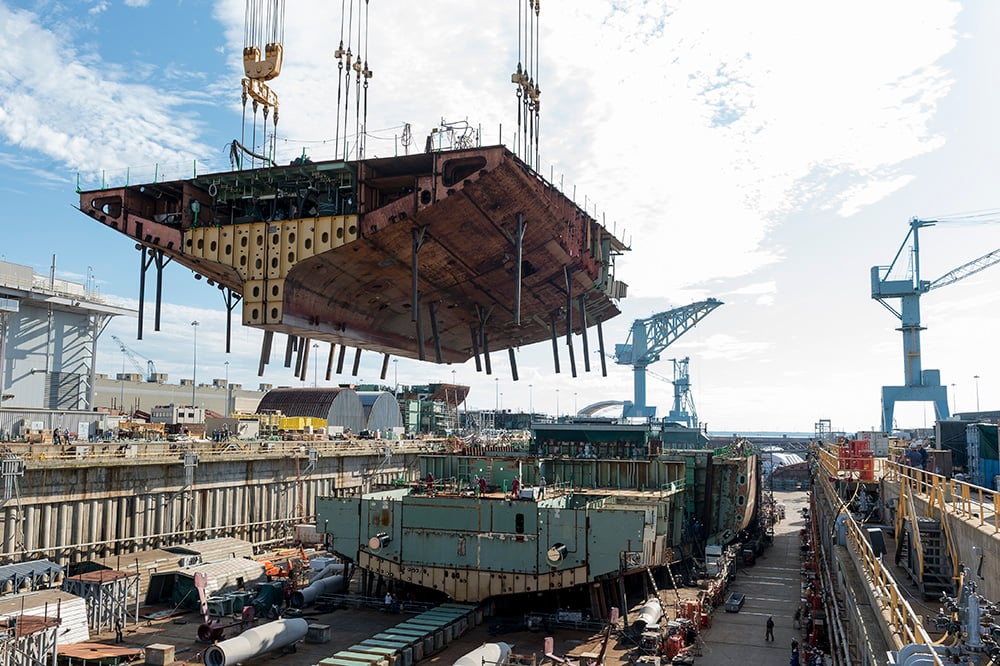Navy Needs Cyber Secretary, Wouldn’t Say No To Truman Refueling: SecNav Spencer
Posted on

Harry S. Truman Carrier Strike Group in the Atlantic Ocean, April 7, 2019.
CAPITOL HILL: The Navy’s top civilian told Congress Tuesday that he’s sending a plan to Capitol Hill seeking to add a new assistant secretary of the Navy to focus on cyber and information issues. Secretary Richard Spencer offered few details about the plan, but he expressed deep concern over hostile parties breaking into private networks and stealing plans for future American weapons systems.
“We need to take immediate remedial actions — which are underway right now with our supplier base — when it comes to our cyber protection,” Spencer told the Senate Armed Services Committee.
But working with contractors is only one part of the fight: The Navy’s own infrastructure and even combat forces are at risk. In any future conflict with an advanced adversary, “it’s not how quickly we can get to the fight,” in the traditional sense of having to sail for weeks to reach the war zone, Spencer said. Instead, he warned, “one of our battles is going to be just getting off of the pier because cyber is around us continually — 100 times a minute, a second — it’s there, its present, it’s not going away.”
He added that the Pentagon as a whole will soon ask Congress “for more authorities” to do not only cyber defense, but increased offensive capabilities.
The new request comes as US officials are increasingly concerned over Chinese and Russian hacks of defense contractors who work on classified military programs. Increasing cyber hygiene was a critical part of the massive defense industrial base study that the Pentagon completed last year, after Chinese hackers barged into US networks and made off with Navy and Air Force data.
Carrier Conundrums
While the Navy is preparing to fight it out in the information and cyber battlefields, it’s still bending steel on massive carriers that will push fifth-generation aircraft into the skies for decades to come.
In that respect, Spencer offered a full-throated defense of the service’s decision to forgo the mid-life refueling of the USS Harry S. Truman, which will take a relatively young carrier out of service decades early. But he also admitted he “would not turn that money down” if Congress gave him enough funding to keep the ship in service without sacrificing other priorities.
Spencer told lawmakers that the new Ford-class carrier — which has endured a growing list of technical troubles while under construction — will eventually vastly outpace the Nimitz-class carriers.
The Fords will have a 30 percent higher launch capability than the Nimitz class, slash the number of sailors aboard by 25 percent, and “is a more efficient machine,” he said. “So as I look at modernizing a fleet, much like in the commercial world when organizations modernize aircraft, trucks, cars, ships, they will go for 25 percent efficiencies and abandon the [older] assets that they have. This not an easy decision whatsoever, but in light of the technologies we have coming forward — and I defer to [SASC chairman James Inhofe] that there’s still work to be done here — the thought process is we have a much more capable, much more lethal, much more projecting platform” on the way in the form of the Ford carriers.
The argument that the Truman is being killed in order to allow the Ford to live is one that Acting Defense Secretary Patrick Shanahan made to the same Senate panel last month.
Shanahan argued that the January deal with contractor Huntington Ingalls for the first two first Ford-class carriers increases “the lethality” of the carrier fleet, while keeping shipyard employees at work, as opposed to allowing a gap between the first and second Ford ships. “In fact, with the decision, we grow employment in the industrial base,” Shanahan said. “We want to make sure that not only the shipyards maintain their employment, there’s actually growth [in the] supply chain. The last [point] is the funds that we freed up making these decisions are invested in the future force.”
Just the day before Shanahan spoke however, the Chief of Naval Operations, Adm. John Richardson, told a group of reporters that the Truman retirement and the two-ship Ford buy are unrelated.
“I don’t think they are connected. The two-carrier buy is a statement about the aircraft carrier moving forward,” Richardson said. “The decision on Truman is really connected to balancing capabilities between 25 years of the Nimitz-class aircraft carrier against the requirements, which are being studied. Also, this idea that we want to make sure we’re not missing opportunities to exploit technology. I don’t see them as being tightly coupled.”
That argument appears to have been overruled by the Shanahan/Spencer line that since the Ford carriers are better, the Navy needs money, so the Truman has to go early.
The Navy has assessed that by cancelling the mid-life overhaul on the Truman, it will save $3.4 billion over the five-year defense plan, while the two-carrier buy will save $4 billion.
But issues remain. Last month, Navy officials told the House Armed Services Committee that the Ford will suffer another delay in its delivery, and won’t be ready until October, instead of July as initially planned.
The delay will allow for more fixes to the Ford’s nuclear propulsion system and Advanced Weapons Elevators, Navy acquisition chief James Geurts said: “October right now is our best estimate. The fleet has been notified of that. They’re working that into their train-up cycle afterward.” The first operational elevator was put into action in December.
Subscribe to our newsletter
Promotions, new products and sales. Directly to your inbox.




